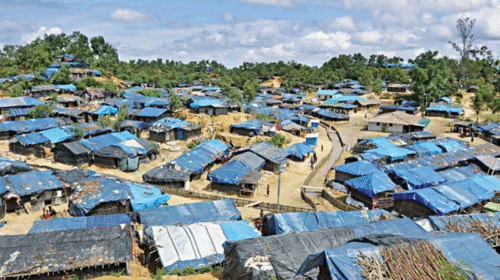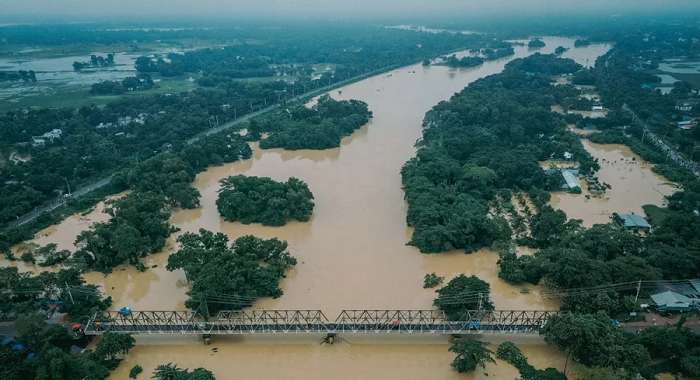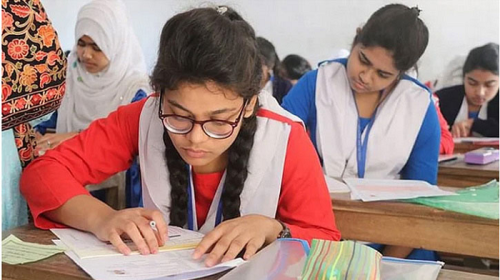The Crime Desk: 11 districts of the country have been flooded due to heavy rain and upstream water in India. 15 people, including two women, have died in the floods so far. More than 48 lakh people have been affected.
For the people of Feni district among these districts, this flood is on the one hand sudden and on the other unimaginable. Not only Feni, but the adjoining districts of Comilla, Noakhali, and Fatikchari in Chittagong have taken an aggressive form. In many places, the flood water has touched or overflowed the houses.
Various analyses are going on about this flood situation in these districts near the Indian border. Residents of these districts say that floods do not usually occur in these areas. However, analysts say that the information that floods do not occur in these areas is not correct.
Experts said that heavy rains in India’s Assam and Meghalaya are a major factor, but there are other factors behind these floods. For example, loss of water carrying capacity of rivers. Due to the loss of navigability of the rivers in that region, the excess rainwater from Meghalaya or Assam cannot flow out of Haor through Meghna or Yamuna to the Bay of Bengal. Along with this, many blame the unplanned development of Haor area including Sylhet.
According to a BBC Bangla report, water resource and climate change expert Ainun Nishat said about the cause of such a terrible flood, Comilla and Feni used to flood every year even 30 years ago. Due to floods, Gomti was called the sorrow of Comilla. The reason there is no flood now is because the dam holds the water. This dam was done by India for their benefit; it also benefited us.
Ainun Nishat says that it has rained more than the three days in the middle of August that should have rained in the whole month. Besides, if the amount of rain that has occurred in that region of Bangladesh, including Tripura Mizoram, had been in Dhaka, then 80 percent of the area of Dhaka would have been submerged. As a result, only heavy rains can be considered for flooding.
Sardar Uday Raihan, Executive Engineer of the Flood Forecasting and Warning Center, said, “Floods do not occur at all, not at all” in Comilla, Feni, and Chittagong. However, compared to other years, this year the flood has been more.
He said that in recent times there has not been such a big flood in Comilla. But Feni, Habiganj, and Moulvibazar are usually flooded. This year there has been a large-scale flood in more areas, resulting in more damage. After 2007, this is the first major flood in Comilla. However, such floods are seen in Habiganj and Moulvibazar in 2018 as well.
Chairman of the Water and Environment Institute. Inamul Haque said this disaster is not unusual. Rather, Feni is a flood-prone area. And Muhuri-Kahua-Silonia—these three rivers surround the district.
He said there is a flood prevention dam on the side of the river. These dams can prevent minor floods, not major floods. As a result, the heavy rains that have occurred in Mizoram and Tripura have moved from upstream to downstream. And one of the effects is local depression. Because the clouds cannot move north if there is local low pressure. As a result, it continues to rain in a place. Localized low pressure caused heavy rains and floods.
A study by the Grantham Research Institute on Climate Change and the Environment and the Center for Climate Change Economics and Policy was published in August last year on the flood situation in Bangladesh.
It says that 60 percent of people in Bangladesh are at high risk of floods. Besides, 41 thousand 783 people lost their lives in 78 floods from 1971 to 2014, i.e., 43 years. And it caused an economic loss of 12.2 billion dollars.
Citing the Asian Development Bank (ADB), it said that economic losses from the 2014 floods alone amounted to two and a half billion dollars, which is about one and a half percent of the country’s total GDP.
The report also mentions that the 2022 floods caused 7.3 million people and one billion dollars in damages. Source: BBC.

















